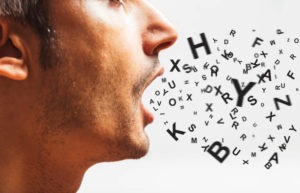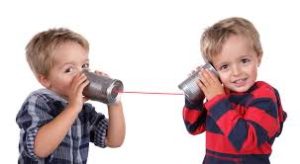Echolalia is the repetition of others’ words, including family members, teachers, or something someone hears on TV, through music, or other means. It is an adaptive response when a person struggles with saying their own thoughts through speech. Recent research shows that echolalia is often a means of communication.
Language Development
 Most kids use echolalia as a natural way to learn language – to learn words, rhythm, inflection and tone. In typically developing children, echolalia peaks at 30 months and fades by the time the child is 3 years old. Often echolalia is a developmental step in an autistic child’s language and cognitive development; about 75% of children with ASD exhibit echolalia [NIH]. It can be considered a positive sign in children with autism, as it may be the foundation for further language development. Gradually overtime language becomes less rigid.
Most kids use echolalia as a natural way to learn language – to learn words, rhythm, inflection and tone. In typically developing children, echolalia peaks at 30 months and fades by the time the child is 3 years old. Often echolalia is a developmental step in an autistic child’s language and cognitive development; about 75% of children with ASD exhibit echolalia [NIH]. It can be considered a positive sign in children with autism, as it may be the foundation for further language development. Gradually overtime language becomes less rigid.
 Children with ASD develop language differently than a typical child. A typically developing child learns individual words, then creates phrases and finally forms more complex sentences. Kids with ASD mimic larger phrases that are too complex to fully understand. Many children with ASD learn language first by assigning meaning to a phrase they hear. They are unable to break the phrase down into smaller words and they don’t understand what the individual words mean [Hanen Centre]. They know the phrase “It’s your bedtime” means bed, but they are unable to use those individual words to make other sentences. Then as the child learns more phrases, the child begins to and mix and match single words. Finally, the child creates unique phrases and then forms grammatically correct sentences. As language comprehension improves, echolalia becomes less verbatim and more flexible [NIH].
Children with ASD develop language differently than a typical child. A typically developing child learns individual words, then creates phrases and finally forms more complex sentences. Kids with ASD mimic larger phrases that are too complex to fully understand. Many children with ASD learn language first by assigning meaning to a phrase they hear. They are unable to break the phrase down into smaller words and they don’t understand what the individual words mean [Hanen Centre]. They know the phrase “It’s your bedtime” means bed, but they are unable to use those individual words to make other sentences. Then as the child learns more phrases, the child begins to and mix and match single words. Finally, the child creates unique phrases and then forms grammatically correct sentences. As language comprehension improves, echolalia becomes less verbatim and more flexible [NIH].
 Communication
Communication
Echolalia can be directed at a person or not, and it can be communicative or not. Echolalia can be used to ask for something, to interact with others, to bring attention to something, to express mood, to protest, give directions or to answer yes or no [Hanen Centre]. It’s important to keep in mind the original context of the phrase being repeated. This can help you understand the reason for and meaning behind the phrase being repeated. For example, a child might repeat “Hakuna Matata”. This may mean the child simply wants to watch Lion King, or that the they associate “Hakuna Matata” with joy and they are telling you they feel happy. It may be said when they see a lion (draw attention to something) or might be asking for a toy lion.

It is important to be able to differentiate when your child is trying to communicate something or is just echoing what they heard. For example, you say to a child, “Hi, how are you?” and they repeat, “Hi, how are you?” On the surface this may look like they are trying to have a conversation, but chances are the child doesn’t know what they are actually saying and is simply immediately repeating what they just heard. Echoing, “Hi, how are you?” may not have meaning at first, but overtime and several interactions the child will learn that this is an appropriate response to say to someone when you see them and they will be able to independently greet someone.
Autistic kids are also more likely to use echolalia when they haven’t learned the appropriate response to a question. Teaching the child an appropriate response can help phase out echolalia, even if it is as simple as “yes”, “no”, “I don’t know”, “I feel _____”, “I want _____”, or “I don’t like _____”. By taking the echoic response and teaching it as a predictable rule, the phrase begins to control behavior over time.

There are instances when echolalia is not a means of directed communication. Scripted speech is when a child repeats a word or phrase he heard and uses the phrase out of context and it is not an attempt to communicate. Scripted speech almost looks like babbling, or like the child is talking to themself, in their own little world. This may look like a child singing “E-I-E-I-O” or repeating something they heard to themself. Nonverbal cues like body language, direction of their eye gaze or gestures can also be a clue to whether or not the child is trying to communicate.
What To Do If Your Child Has Echolalia
- Meet with a Speech Language Pathologist (SLP) to help your child learn to effectively communicate
- Use phrases that you want your child to repeat (“it’s my bedtime”)
- Teach appropriate responses to common questions and greetings
- Keep in mind the original context of the phrase being repeated
- Remember it can be a normal part of autistic development
Additional Resources:
The Hanen Centre has great information on language development and autism. Autism Parenting Magazine also has some useful information on echolalia as well. The National Institute of Health has some more technical information. Finally, visit the American Speech-Language-Hearing Association for more general information on language disorders.
Interested in services? Visit our website to submit a service inquiry form here. Let us know what topics you would like to learn more about: office@abainsight.net

 Communication
Communication